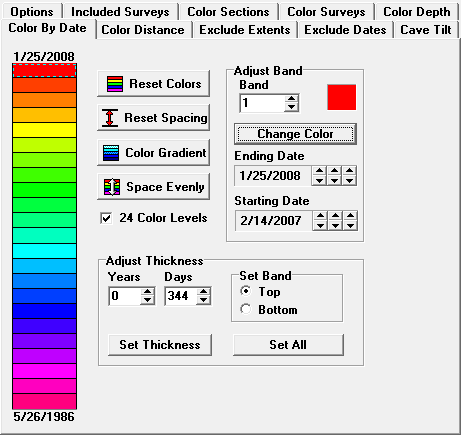The Color-By-Date option allows you to do complex coloring based on the date that a passage was surveyed. This is different than the simple Color-by-Year option that is available from the main menu. With the Complex Color-By-Date option, you have complete control of the color and the beginning and ending date for each color.
Color-By-Date Page. The Color-By-Date page presents a "Color Bar" on the left side of the page that graphically illustrates each color band. Each color band represents a particular range of dates in the cave. By manipulating the color bands, you can map any color to any set of dates. You can even do non-linear coloring, which is very useful for visualizing the progress of surveying in the cave. You can manipulate the color bands in several ways:
Selecting Colors. You can select any color by clicking-on it. When a color is selected, a dotted line appears around the border of the color band. Once a color is selected, you can change the color by clicking-on the "Change Color Button." You can also change the range of dates that applies to a color by clicking-on the arrow-buttons next to the "Starting Date" and "Ending Date" boxes.
Dragging The Tops and Bottoms. You can also manipulate the Start and End values of a color band by moving the mouse cursor to the line separating the bands and then dragging the band to a new position. If the band you are dragging is selected, the numbers in the Start and End edit boxes will change as you drag, so you can see the numerical values of the result. |
|
Dragging Colors. You can also copy colors from one band to another by clicking-on a color band and then dragging the color to a new band. This will copy the color to the new band.
Reset Spacing. The "Reset Spacing" button restores the original even spacing of the bands.
Reset Colors. The "Reset Color" button restores the default colors of the bands.
Color Gradient. The "Color Gradient" button takes the top and bottom color bands and creates a smoothly changing series of intermediate colors. This is useful for creating special color effects. Because of dithering problems, color gradients only work well on with high color resolution graphics modes. If you want to use this feature, you must put Windows in 16 or 24-bit color mode.
Space Evenly. The "Space Evenly" button takes the top and bottom of the color bar and spaces all the bands evenly. This allows you to set a narrow range of evenly spaced color bands. The "Space Evenly" button is different from the "Reset Spacing" button. The "Reset Spacing" button resets the color bar to the original spacing; whereas, the "Space Evenly" button maintains the position of the top and bottom bands and then evenly spaces all the intermediate bands.
24 Color Mode. This option sets the color bar so it has a rainbow of 24 colors. Click here for more information about 24 Color Modes
Adjust Thickness. It is sometimes useful set to the thickness of a color bar. Although, you can set the thickness by setting the top and bottom of a bar, it requires a mental subtraction. The "Adjust Thickness" section allows you to directly set the thickness of one or all color bands.
By pressing the "Set Thickness" button, you set the thickness of the selected band to the current thickness. By pressing the "Set All" button, you set all bands the to the current thickness. You also have the option of setting the top bar or bottom bar of each band.
Depth Bars. You can use the Depth Bar option to display a legend on the plot showing the meaning of the colors.
Note. If the survey dates are missing or in error, coloring by date can give strange results. For example, some people enter zeros for the date when the exact date of the survey is unknown. This leads to surveys that appear to be hanging in space because the connecting survey's date is incorrect.
